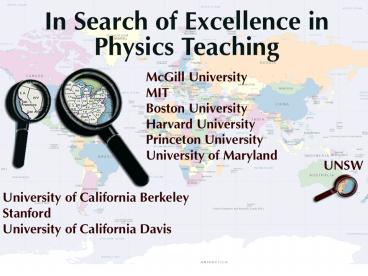McGill University Department of Physics - PowerPoint PPT Presentation
1 / 41
Title: McGill University Department of Physics
1
(No Transcript)
2
(No Transcript)
3
(No Transcript)
4
(No Transcript)
5
(No Transcript)
6
(No Transcript)
7
(No Transcript)
8
(No Transcript)
9
- Interview with Joe Redish about Dickinson Layout
and Science thinking
10
MIT Physics Department
11
Artists Impression
12
Technology Enabled Active Learning
ClassroomWhiteboards fill the walls. Seats 117
undergraduate students
13
Teal 7metre table for 9 people and 3 connection
areas for laptops, equipment and PRS
14
Lecturn for academic several projectors and a
document scanner for small demos. Also note the
mics for students responding to questions
15
One data projector per screen. Movie cameras for
each whiteboard seems like overkill (one graphics
card and data projectors could have sufficed)
16
Personal response systems used judiciously to
procure student feedback.Results displayed on
the screen within seconds of everyone answering.
17
Wheels on chairs ensure easy free movement
18
Whiteboards for staff and student use Note
switch activates movie camera
19
Lighting and carpet create lounge room ambience
20
Sufficient table spacing to minimise noise from
neighbouring groups
21
Foyer with pics of the exciting labs that take
place
22
Prep room for 1st year
23
All 1st year labs use small portable equipment
24
Compare Teal with boring lecture hall where
attendance is now a real problem
25
TEAL Studio Physics
- Technology-Enabled Active Learning
- John Belcher Interview
26
- TEAL Technology-Enabled Active Learning
- A merger of lecture, recitations, and hands-on
laboratory experience into a technologically and
collaboratively rich environment
- MIT students interviewed
27
Instructors mentor group experiment and discussion
28
Main Study Pre vs. Post Conceptual Test Scores
N 121
N 176
Experimental group II - Fall 2001
Control group II - Spring 2002
For the experimental group, the correlation
between the conceptual pre-test scores with
students final course scores was 0.34 (p lt
0.0001).
29
(No Transcript)
30
Princeton Physics Department
31
Wooden sliding door leads to ancillary classroom
used for pre and post lab sessions
32
Ancillary classroom with blackboard for use by
students and TAs
33
University of California Davis
34
Undergrad labs are run together with tutorials as
2 x 2.5hr discussion labs supplemented with 1hr
of lecture time.
- Interview with Wendell Potter about groups of 5
35
5-6 groups of 5 students collaborate on the
exercises. Each group has one blackboard and one
experimental setup.Groups are self selecting on
the whole.
36
There are discussions amongst the groups of 5
before and after the hands on exercises. The
class is run by a TA who calls together the class
as a whole for discussion at key points. The
class has a maximum of 25-35 students.
37
The constant hub of activity and discussion is
testament to the fact that students find it an
engaging experience.
- Interview re gender differences
38
Note configuration of tables. Hexagonal
collaboration area and rectangular area for
equipment. Tables made from old doors in workshop.
39
Similar arrangement in another freshman lab Note
one whiteboard per table
40
Traditional table set up in sophomore lab, no
obvious educational vision that ties first year
and later years together. Lab directors seem to
work fairly independently, probably to maintain
harmonious relationship.
41
Summary
- MIT and UC Davis have custom designed their labs
to enable a certain flexible teaching style to be
implemented that combines elements of lectures,
tuts and traditional labs in a collaborative
setting. - Compare with Berkeley who are planning folding
walls, movable tables etc but have made no firm
commitment to any direction in pedagogy. - Which model is preferable?































